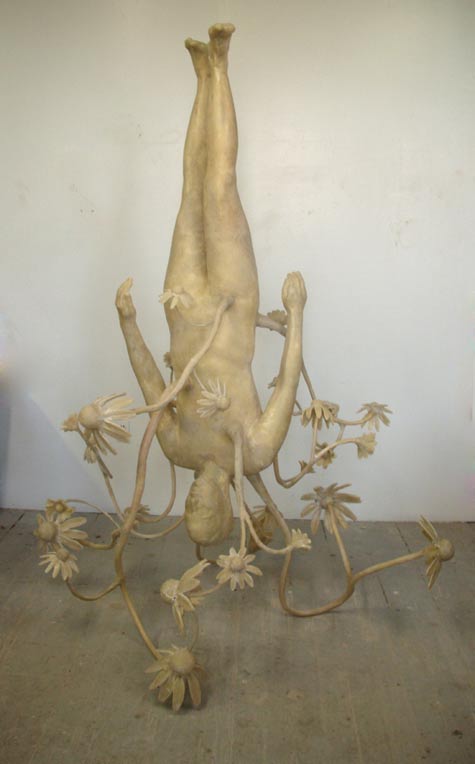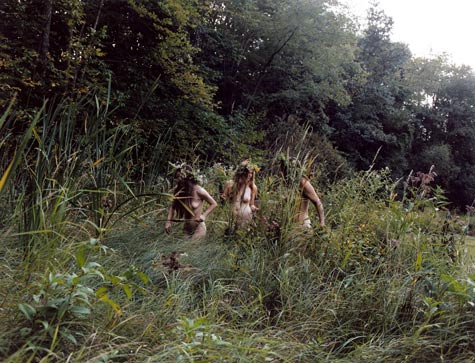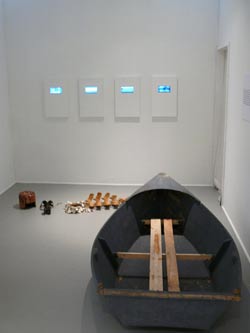
WALKING Tory Fair's sculpture has the effect of a beautiful, magical transformation — with a creepy aftertaste. |
Nature is mysterious and mystical in "And the fair Moon rejoices" (at the BCA's Mills Gallery through August 16), as foreign as the wilds of New England probably seemed to its first English settlers. And maybe there are witches about.
This lyrical show was organized by Emily Isenberg, formerly director of LaMontagne Gallery, and Randi Hopkins, who co-ran Allston Skirt Gallery and wrote for the Phoenix before becoming a curator at the Institute of Contemporary Art. The title comes courtesy of William Blake, the result of the curators' thinking that these six artists are "contemporary visionaries" in Blake's wake.
In New Yorker Justine Kurland's staged photos, folks frolic nude outdoors, as if in some flower-child community-theater follies. Hunters shows three naked ladies with flower-garland crowns walking in tall grass like muses or fates or witches. The mythological symbolism and playacting may be New Age cheese, but the odd doings intrigue.
Arlington artist Tory Fair's Walking is a rough-cast-rubber sculpture of an upside-down woman (cast from the artist's own body) with a chandelier-like structure of flowers sprouting from her torso to hold her off the floor. The effect is reminiscent of Kiki Smith — a beautiful, magical transformation, with a creepy aftertaste. The sculpture's glossy yellow surface is like a slimy cocoon; the flowers are an infestation.

Justine Kurland, Hunters, 2004, C- print, Edition of 5, 25 x 29 1/2 framed, (NUDES) |
Brooklynite Larry Bamburg's Iceburg [sic] et cetera and so on could be a model of a universe, with its mountain made of crumpled paper taped atop two Plexiglas pedestals orbited by bits of lint and a dead fly. The orbiting things are actually suspended from a mobile spun by a fan, which also jiggles a fishing line that wiggles the legs of a little paper deer crushed under the pedestals. It's endearingly half-assed, charming because its jury-rigged complexity transforms its simple parts into a world.The rest of the show's dreaming about the great outdoors is less interesting, but everything hangs together elegantly. The connections Hopkins and Isenberg propose feel intuitive, so the group is greater than the sum of its parts.
At first, "Momentum 14: Rodney McMillian," which has been organized by curator Nicholas Baume at the ICA (through November 1), struck me as your usual nihilist non sequitur masturbation. McMillian's installation Sentimental Disappointment fills one wall with a sketchy black painting of his Los Angeles house. Furniture from his home sits around the gallery: a chair with an eight-foot-tall black column driven through its seat, a refrigerator with a hole punched through the door, a dinged-up kitchen table and chairs with a television on top.

Submersions, Installation view. David Olsen, 2009 |
It seems random, except that the television plays a 25-minute video of the artist stabbing a mattress repeatedly with a large kitchen knife — like something out of Psycho— and then ripping it apart with his hands. It's performance art, so McMillian performs it like a chore, but his act makes all the art here feel like domestic violence. A video playing outside the gallery of McMillian dancing desultorily to Porgy and Bess could point to frustrations of race (the artist is African-American) and poverty. Or not. I feel myself straining to find meaning in these forlorn objects. How much should we give artists the benefit of the doubt?
Read Greg Cook's blog at gregcookland.com/journal.